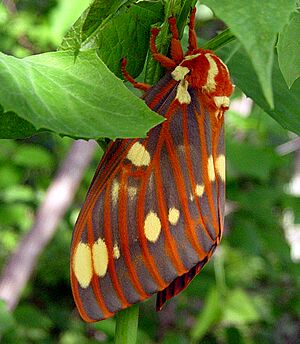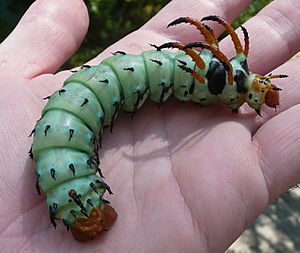Regal moth facts for kids
Quick facts for kids Regal moth |
|
|---|---|
 |
|
| Scientific classification |
The Citheronia regalis, also known as the regal moth or royal walnut moth, is a large moth found in North America. Its amazing caterpillars are often called hickory horned devils. Adult regal moths have a wide wingspan, usually between 3.75 and 6.1 inches (9.5 to 15.5 cm). This moth was first described by Johan Christian Fabricius in 1793.
Contents
The Regal Moth's Life Cycle
The regal moth is one of the biggest moths by weight in North America, especially north of Mexico. Its larva (caterpillar) and pupa (the stage before it becomes an adult) are also quite large.
The moth's life cycle is similar to other moths in its family, the Saturniidae. Unlike some moths that spin a cocoon, the regal moth caterpillar burrows into the ground to become a pupa in a small dirt chamber.
Eggs and Young Caterpillars
The eggs of the regal moth are yellowish and oval-shaped, about 2 mm wide. The female moth lays them one by one, or in small groups of up to four, on the top side of leaves. They prefer to lay eggs on nut trees like walnuts and hickories. In some areas, they might use sweet gum, persimmon, or sumac trees if nut trees are not available.
When the eggs hatch after 7 to 10 days, tiny yellow larvae appear. These young caterpillars quickly turn darker. At first, they only eat at night. During the day, they curl up in a "J" shape and look like bird droppings. This helps them hide from predators.
Growing Up: The Hickory Horned Devil
As the caterpillars get older, they start to eat during the day too. They shed their skin four times as they grow. Each time they shed, they look a bit different. In their fifth and final stage, they become a bright green color. They also grow huge, red horns with black tips. This is how they get their famous name: hickory horned devils.
These caterpillars eat a lot for about 37 to 42 days. They can grow up to 15 cm (about 6 inches) long! Even though they look scary with their horns, they are actually harmless. Their spines do not sting, and you can handle them safely.
Pupation and Adult Moths
Just before the caterpillar turns into a pupa, it cleans out its gut. Its color changes from green to a shiny turquoise. Then, it crawls down from its host plant and burrows into the soil. It makes a small chamber about five to six inches deep to pupate. The pupae are dark brown or black. Some pupae stay underground for two seasons before emerging. This might help them survive bad weather or events like fires.
When the adult moths emerge (this is called eclosing), they need to pump a fluid called hemolymph into their wings to make them expand. Female moths then release special scents called pheromones. Male moths can smell these pheromones with their large, feathery antennae. Males can fly for many miles to find a female.
After mating, the female moth spends most of her remaining life laying eggs. Male moths might mate with several females. Adult regal moths have very small mouths that don't work. This means they cannot eat. Because of this, adult moths only live for about one week.
Regal moths usually have one generation per year. They are most active in mid-summer, from late June through August. The caterpillars are most common from August through October.
Where Do Regal Moths Live?
The Citheronia regalis moth is common in the American Deep South. However, it becomes less common as you go further north. You can find it in the forests of the United States, from Missouri and Pennsylvania all the way to Massachusetts. It also lives south from Texas to central Florida.
In the past, these moths were found all over New England. But their numbers went down in the northeastern Atlantic states in the mid-1900s. Today, they are mostly stable in the mid-Atlantic states and southern Appalachia. This area stretches from southern New Jersey west through the Ohio Valley, to the edge of the Great Plains states, and south to East Texas. In the state of Connecticut, the regal moth is considered a species of special concern and is believed to be gone from the state.
Images for kids






